
Imagine you’re at the beach, standing on the sand, and watching the water. Sometimes, the water is very high, and other times it’s quite low. Have you ever wondered why this happens? It’s not just because of the wind or the waves; it’s because of something amazing called tides.
Tides are like the ocean’s special dance. They’re like the ocean’s way of saying “hello” and “goodbye” to the land. But did you know that there isn’t just one type of tide? There are different kinds, and they have their own secrets.
Contents
Semidiurnal Tides: The Ocean’s Marvelous Rhythm🐟
Have you ever noticed that the sea sometimes acts like a giant elevator? It goes up and down. That’s no magic trick; it’s something called “tides.” Today, we’re going to explore a particular type of tide called “Semidiurnal Tides,” which is like the ocean’s special dance routine.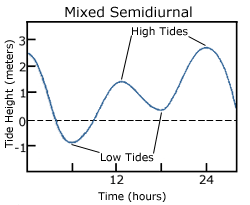
Understanding Semidiurnal Tides:
“Semidiurnal Tides” might be a bit tricky to say, isn’t it? But don’t worry; it’s not as complicated as it sounds. It simply means “twice a day.” These tides follow a pattern where they rise and fall twice a day. Imagine it as a gentle sea-breathing exercise: inhale, exhale, inhale, exhale.
What Makes Semidiurnal Tides Happen:
Now, let’s delve into why these tides occur. It’s like a dance partner, and the Moon plays a huge role. The Moon is like the ocean’s best friend. It attracts the sea with its gravity, just like a magnet. When the Moon is close to a place, the sea rushes to say hello, making it high tide. But when the Moon goes away, the sea waves goodbye and becomes low tide.
Prominent Places for Semidiurnal Tides:
Semidiurnal Tides can be observed in many places around the world, but some spots are famous for these beautiful ocean moves. One such place is the Bay of Fundy in Canada. There, the tides rise as high as a four-story building, showing the incredible power of these twice-a-day tides. You can also experience Semidiurnal Tides in the United Kingdom, like in the Severn Estuary.
Diurnal Tides: The Ocean‘s Daily Dance🐟
Hey there, young explorers! Have you ever been to the beach and seen how the ocean likes to play a game of “now you see me, now you don’t” every day? Well, that’s not just the sea having fun; it’s something super cool called “tides.” Today, we’re going to dive into one type of tide known as “Diurnal Tides,” and it’s like the ocean’s daily dance party.
Understanding Diurnal Tides:
Diurnal Tides are like the ocean’s way of saying “hello” and “goodbye” every single day. These tides follow a pattern where they rise and fall just once in a 24-hour period. Imagine it as the ocean’s way of taking a deep breath in the morning and letting it out in the afternoon.
What Makes Diurnal Tides Happen:
So, what’s the secret behind these daily tides? It’s a tag team effort between the Earth and the Moon. The Moon, which is the Earth’s closest buddy, plays a crucial role. It pulls on the ocean’s waters with its gravity, just like a giant magnet. When the Moon lines up with a place, the sea comes rushing in, and it’s high tide. But when the Moon moves away, the sea retreats, and it’s low tide – like a game of hide and seek with the ocean.
Notable Regions for Diurnal Tides:
You might be wondering where in the world you can catch these daily tides in action. Well, you’re in for a treat because Diurnal Tides are more noticeable in certain parts of the globe. Places like the Gulf of Mexico and the East China Sea are famous for their Diurnal Tides. You see, it’s like a special ocean club where the sea shows off its daily dance moves.
Mixed Tides: When the Ocean Can’t Make Up Its Mind🐟
Hey there, young ocean enthusiasts! Have you ever been to the shore and seen something strange happening with the sea? It’s like the ocean can’t decide whether to go high or low. Well, don’t worry; you’ve just witnessed “Mixed Tides,” a bit of an oceanic puzzle. Today, we’re going to unravel the mystery of Mixed Tides.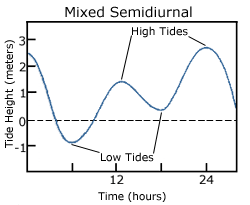
Understanding Mixed Tides:
Mixed Tides are like the ocean’s quirky personality. They’re a mix of both high and low tides in one day, and they don’t follow a strict twice-a-day or once-a-day pattern. It’s as if the ocean is feeling a bit indecisive – like, should I go up or down today? But this makes them fascinating because they’re a bit of a puzzle, unlike the more regular tides we talked about earlier.
How Mixed Tides Differ:
Now, you might be wondering how Mixed Tides are different from the other tides we’ve explored. Well, they stand out because they don’t follow a predictable routine like Diurnal Tides (once a day) or Semidiurnal Tides (twice a day). Instead, they do their own thing, mixing high and low tides whenever they please. It’s like the ocean’s way of keeping us on our toes!
Geographical Factors Influencing Mixed Tides:
One cool thing about Mixed Tides is that they’re like a secret code written by the ocean, and geography plays a big role in decoding it. Imagine the shape of the coastline, the depth of the ocean floor, and the nearby land masses as the ingredients in this oceanic recipe. Some places, like the Bristol Channel in the United Kingdom, have a unique geography that stirs up Mixed Tides. In these regions, the tides can be as unpredictable as the weather.
Famous Spots for Mixed Tides:
If you’re looking to witness the enigmatic Mixed Tides, head to places like the Bay of Fundy in Canada. Yes, the same place famous for its Semidiurnal Tides also experiences Mixed Tides, making it a double delight for tide-watchers. Other regions to explore Mixed Tides include the Severn Estuary in the United Kingdom and the Gulf of California in Mexico.
Equatorial Tides: Where the Ocean Follows the Sun🐟
Hello there, young explorers! Are you ready for a thrilling journey across the seas to discover something extraordinary? It’s time to set sail and explore “Equatorial Tides,” a unique and mysterious phenomenon in our oceanic world.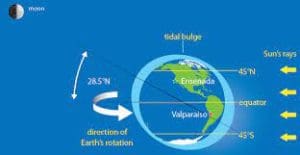
An Introduction to Equatorial Tides:
Equatorial Tides are like the ocean’s special secret, and they do things a little differently near the Earth’s waistline – the equator. Unlike the tides we’ve talked about before, Equatorial Tides don’t play by the usual high-and-low tide rules. They follow their own rhythm, and it’s fascinating!
How the Geographic Equator Affects Equatorial Tides:
Now, let’s dive into why Equatorial Tides are so different. You see, the Earth’s equator is like an imaginary belt that goes around our planet’s middle. It’s the spot where the Sun shines the brightest and the sea experiences something magical. The Sun’s rays hit the equator directly, warming up the water, and making it expand a bit. This expansion causes the sea level to rise, creating a high tide. When the Sun moves away, the sea cools down, and it’s low tide. So, it’s like a dance between the Sun and the ocean at the equator, causing these unique tides.
Where to Spot Equatorial Tides:
If you’re eager to witness these fantastic Equatorial Tides, you’ll need to head to some remarkable places near the equator. One such location is the Galápagos Islands, which are famous for their incredible biodiversity and, of course, Equatorial Tides. Additionally, the west coast of Africa along the Gulf of Guinea is another region where you can experience these special tides.
Unusual Tides: Nature’s Surprising Show🐟
Hey there, young adventurers! It’s time to embark on a thrilling oceanic journey to uncover one of the sea’s most amazing secrets – “Unusual Tides.” These are like nature’s surprises, and they come in different flavors that keep the ocean full of wonder.
Exploring Unusual Tides:
Unusual Tides are a bit like the ocean’s roller coaster. They’re not your regular high and low tides, and they bring a sense of excitement and curiosity. These tides make the sea do unexpected things, and it’s like watching a magical show put on by Mother Nature.
Understanding Extreme Tides:
Now, let’s dive into what makes Unusual Tides so, well, unusual. You see, sometimes the ocean decides to go big – really big. This can happen for various reasons. For example, we have “Red Tides,” which are caused by tiny organisms in the water that make it look red. These tides can be harmful to marine life.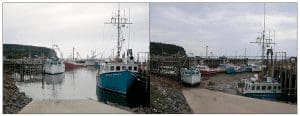
Another type of Unusual Tide is called “Spring Tides.” These are not about the season of spring but about when the Sun, Moon, and Earth are all in a straight line, working together to make extra high high tides and extra low low tides. It’s like a celestial teamwork event in the sky.
The Impact of Unusual Tides:
Unusual Tides can have a big impact on the ocean’s residents and the communities living near the coast. When there’s a Red Tide, it can be tough for fish and other sea creatures, as the toxins released by the tiny organisms can harm them. As for Spring Tides, they can lead to more flooding in coastal areas, which can be a challenge for people who call those places home.
The Importance of Understanding Tides🐟
Hello there, young sea enthusiasts! We’ve taken quite the journey through the world of tides, discovering their different forms and how they affect the ocean. Now, let’s talk about why it’s crucial to understand these mysterious movements of the sea.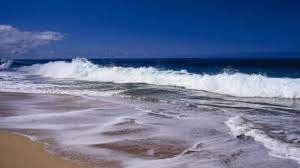
Why Understanding Different Tides Matters:
Understanding the many faces of tides, whether they’re Diurnal, Semidiurnal, Equatorial, or Unusual, is like having a secret key to unlock the mysteries of the ocean. It’s not just about knowing the ocean better; it’s about being aware of how these tides impact our world.
For sailors and fishermen, knowing the tides is like having a map of the ocean’s ups and downs. Tides affect the depth of the water, and understanding their patterns helps boats navigate safely. Fishermen also rely on tides because certain fish like to swim closer to the shore during high tides, making it the perfect time for a catch.
Tides and the Environment:
Tides play a vital role in our environment. They help circulate nutrients, which is like food for the creatures of the sea. Tides also clean the shorelines by carrying away debris and bringing in fresh water. Plus, they affect the temperature and the balance of salt in the ocean, creating unique habitats for marine life.
A Call to Action for Coastal Conservation:
Now, here comes the most important part: taking care of the coasts and the ocean. With climate change and pollution threatening these delicate ecosystems, it’s our responsibility to protect them. We can do our part by reducing plastic use, keeping our beaches clean, and supporting organizations that work to conserve coastal areas.


